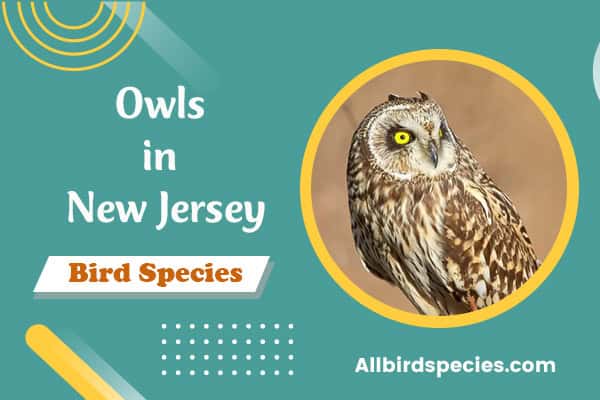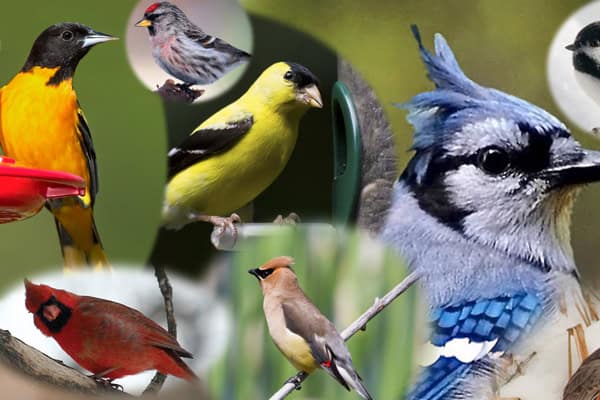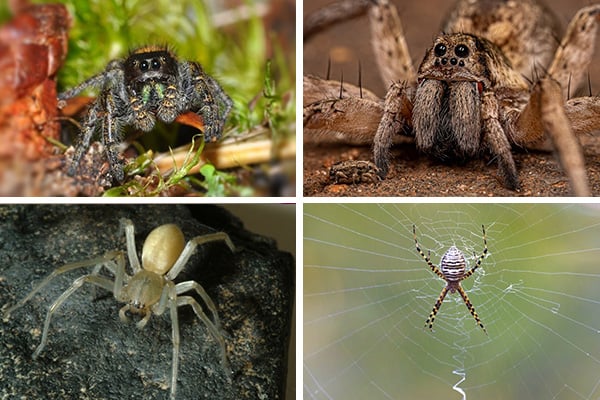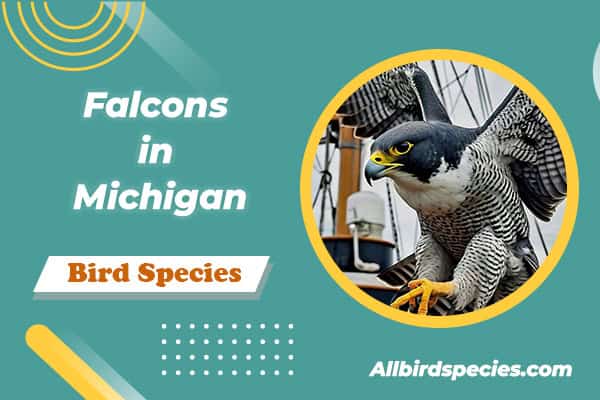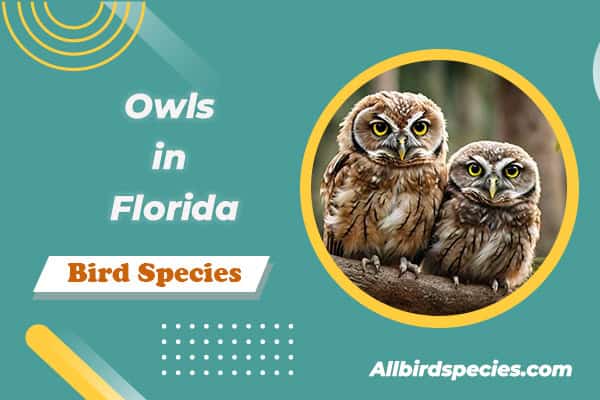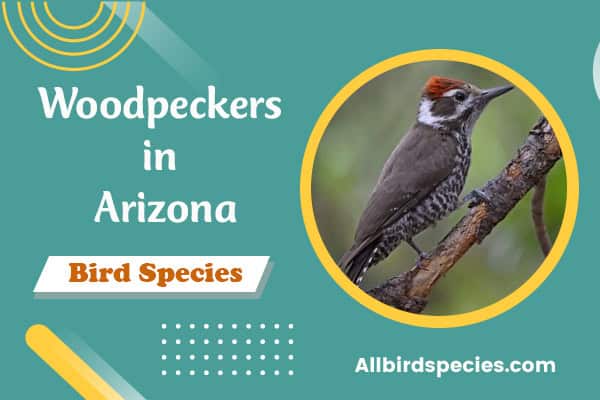9 Types of Owls in New Jersey (ID Guide)
Do you know New Jersey has different types of owls? Eight types of owls live here or visit often, including Jersey’s largest and best-known owl. This makes it a great place for birdwatching and learning about owls.
Owls are most active at dusk and dawn. They hunt small mammals, reptiles, insects, and amphibians. To see them, visit wooded areas at night. Places like Liberty State Park and Great Swamp National Wildlife Refuge are perfect for spotting these birds.
Exploring the Fascinating Owl Types Of New Jersey
New Jersey is home to many owl species. These birds are loved by both nature fans and those who just enjoy watching them. With nine types of owls, we learn about their special traits and where they like to live.
The Diverse Owl Species in NJ
Let’s look at some interesting facts about owls in New Jersey:
- Barn Owls: They have heart-shaped faces. They like to live near grasslands and wetlands, especially in the south.
- Barred Owls: There are about 112 pairs in the state. They are found in many places, showing they can adapt well, including New Jersey’s largest and best-known habitats.
- Short-eared Owls: These owls are now rare. Only a few have been seen in recent years.
- Snowy Owls: These Arctic birds are less common now. They add to New Jersey’s owl diversity.
- Eastern Screech Owls are 7-10 inches tall and belong to the New Jersey owl variety.
- The Long-eared Owl is another fascinating species in New Jersey. They are rare in the state, and we need to protect their homes.
Learning about these owls helps us appreciate New Jersey’s nature. Their role in our ecosystems encourages us to help protect their homes. Here’s a table with important owl species data:
| Owl Species | Estimated Population | Nesting Preferences | Notable Facts |
|---|---|---|---|
| Barn Owl | Common along the southern coast | Near grasslands/wetlands | Chicks banded for tracking; Species of Special Concern |
| Barred Owl | Approx. 112 pairs statewide | Diverse habitats; wide home range for species in New Jersey. | Population growth of 1.1% per year 1966-2019 |
| Short-eared Owl | Rare; ~12 spotted (2008-2009) | Open areas, formerly common | Declining population; once widespread |
| Snowy Owl | Global population of ~29,000 | Open tundras and coastal areas | Significant decline over decades |
| Eastern Screech Owl | Abundant in NJ | Woodlands, suburban areas | 7-10 inches tall; adaptable |
| Long-eared Owl | Rare; specific habitats needed | Dense pine forests | Known for long ears; elusive |
1. Barred Owl
The Barred Owl (Strix varia) is known for its unique sounds and striking looks. Spotting this owl in the evening is a special experience. They have round bodies and a mottled brown color, without ear tufts.

White spots on their chests and a unique face make them stand out. Their famous call, ” Who cooks for you?”, is heard in New Jersey’s forests and wetlands, especially in the Garden State.
Identification and Features
Barred Owls are bigger than many NY owls. They are 16 to 25 inches long and have a wide wingspan. Their round face and soft, dark brown feathers are key to identifying them.
Studying their unique pattern is helpful for birders of all levels.
Nesting Habits
Barred Owl nesting is interesting, particularly in southern New Jersey. They use old stick nests, tree cavities, or nest boxes. In late winter or early spring, females lay one to five eggs.
The eggs incubate for 28 to 33 days. The female does most of the work, while the male brings food.
Where to Find Barred Owls
To see Barred Owls, look in wetland forests and riparian woodlands. High Point State Park and the Wanaque Wildlife Management Area are great places in New Jersey. With patience, we can enjoy the beauty of nature.
2. Short-eared Owl
The Short-eared Owl, Asio flammeus, is special. Unlike many other owls, it hunts during the day, making it a great sight for birdwatchers and nature lovers.
Short-eared owls have light brown feathers with darker streaks. They are often seen quietly flying over fields or marshes.
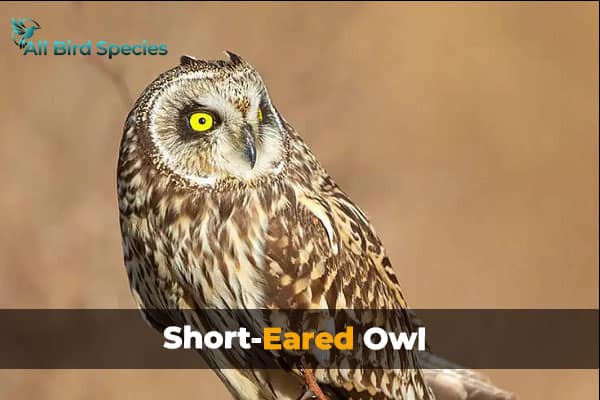
Unique Characteristics
The Short-eared Owl has short ear tufts and a round face. Its wings are long and tapered, helping it fly well during hunts, much like the way hawks soar through the sky. The owl lives in open places like grasslands and wetlands.
They are very good at living in different places. This is why they are found in many parts of the Northern Hemisphere.
Nesting Behavior
Short-eared Owls nest on the ground. They use grasses and downy feathers to make a cozy home for their babies. They usually lay 5 to 6 eggs, but can have up to 11 in good times.
The eggs hatch after 21 to 31 days. This species often has babies hatch at different times.
Feeding Habits
Short-eared Owls eat small mammals like meadow voles and mice. They also eat rabbits or birds sometimes. They hunt by flying low over fields during the day.
This helps them see prey with their sharp eyes, which is important in keeping rodent numbers down in their homes.
3. Snowy Owl
The Snowy Owl, known as Bubo scandiacus, is a stunning sight. Its white feathers make it a favorite among bird watchers. In New Jersey, especially in winter, it’s a big hit.

Signature Appearance
The Snowy Owl’s white feathers help it blend in with the Arctic snow. Males are whiter, while females have dark spots. Seeing them in New Jersey is a thrilling adventure.
Nesting and Migration Patterns
In the Arctic, Snowy Owls build nests for their eggs. When winter comes, they migrate south. They look for food in places like Island Beach State Park and Liberty State Park in New Jersey.
During migration, they eat lemmings and ptarmigan. But they also hunt other small animals and birds.
| Characteristic | Details |
|---|---|
| Scientific Name | Bubo scandiacus |
| Migration | South to New Jersey during winter |
| Nesting Locations | The Arctic tundra is one of the many diverse habitats where owls may be found. |
| Appearance | Striking white plumage, darker markings on females |
| Diet | Lemmings, ptarmigan, small mammals, and birds |
| Winter Spotting Locations | Island Beach State Park, Liberty State Park |
4. Northern Saw-whet Owl
The Northern Saw-whet Owl, known as Aegolius acadicus, is small but fascinating. It’s one of the smallest owls in the US. Its brown back and white-spotted face make it a favorite among bird lovers.

Size and Weight
This owl is tiny, weighing about 3 ounces. Its small size helps it move easily in dense forests. It’s hard to spot because of its size.
Diet and Hunting Strategies
The Saw-whet Owl eats small mammals, like white-footed mice. It hunts at night, using its great hearing and eyesight. It can jump from a perch or swoop down to catch its prey.
It also eats voles and sometimes birds. This shows how adaptable it is. Its hunting skills are important for keeping the forest healthy.
| Feature | Details |
|---|---|
| Scientific Name | Aegolius acadicus |
| Size | 7 to 9 inches |
| Weight | About 3 ounces |
| Main Diet | White-footed mice, voles, and small birds |
| Hunting Time | Primarily nocturnal |
5. Great Horned Owl
The Great Horned Owl (Bubo virginianus) is fascinating because of its unique features. It has tufted feathers that look like horns. This bird is a top predator in its world.
It has a big wingspan and is heavy. These traits make it easy to spot for those who know what to look for.

Identification Tips
Spotting Great Horned Owls is fun. Here are some key things to look for:
- Large size with a height of 18-25 inches (45-63 cm).
- Distinctive ear tufts give it a unique silhouette.
- Brown and white mottled plumage, offering excellent camouflage.
- Bright yellow eyes that stand out against the darker facial disc.
When you see these birds, remember they like different places. They live in forests and cities too.
Behavior and Feeding
Great Horned Owl behavior shows they are smart and good hunters. They can catch many kinds of prey, like:
- Mammals such as rabbits and rodents.
- Birds, including other raptors.
- Occasional reptiles and amphibians.
They hunt quietly and use strong talons. This helps keep the balance in their homes.
6. American Barn Owl
The American Barn Owl (Tyto furcata) is known for its haunting presence, similar to that of the Barred Owl’s. It has a heart-shaped face and lives at night. This owl helps control rodent populations in its habitats.
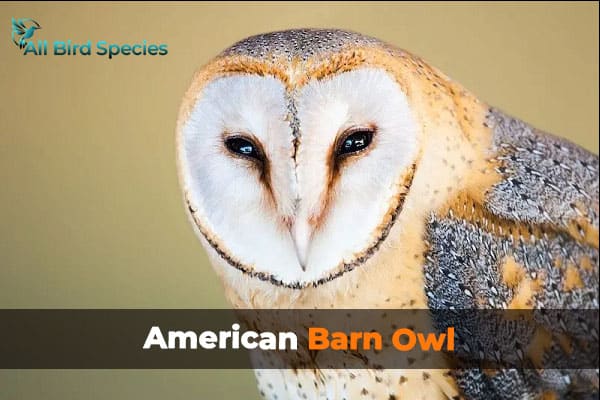
Distinctive Features
The Barn Owl has pale, mottled feathers for camouflage. It can hear prey in the dark. Its diet mainly includes rodents, helping ecosystems.
They make unique sounds like hisses and screams. These calls help them talk to each other or warn others.
Habitat Preferences
Barn Owls love agricultural areas, old barns, and open fields. These places offer good nesting sites and food. However, their numbers are down in New Jersey due to habitat loss.
But efforts like nest boxes from the Raptor Trust are helping. Together, we can protect and keep the American Barn Owl in our skies.
7. Eastern Screech Owl
The Eastern Screech Owl, known as Megascops asio, is very adaptable. It lives in many places, even cities. People love it for its colors and sounds.
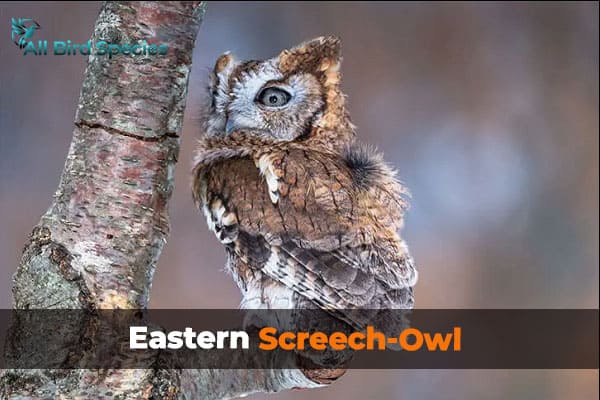
Color Variants and Features
These owls have two main colors: grey and rufous. This helps them hide in the woods. They are small, about 7 to 10 inches tall.
They have ear tufts and big yellow eyes. This makes them easy to spot and very cute.
Vocalizations and Communication
Their sounds are important for them, especially when communicating with other species of owls. They make tremolo calls. These calls help them mark their territory and find mates.
8. Long-eared Owl
The Long-eared Owl (Asio otus) is a fascinating part of New Jersey’s bird world. It has long ear tufts and can hide well, making it hard to see for most people, particularly in winter.
These owls like to be alone when hunting. But in spring, they like to be with others. They live in groups in forests. The males make sounds that fill the woods, especially in spring.
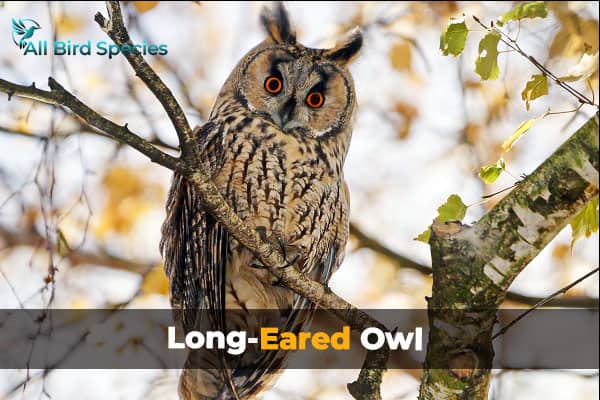
Studies show their numbers are going down. In Pennsylvania, they are considered threatened. People are working to save their homes in places like Bucks and Lebanon counties, which are vital for the common owl in New Jersey.
The Long-eared Owl likes different places like woods, fields, and wetlands. Knowing where they live helps protect them. By learning more about them, we can help save this special bird.
9. Short-eared Owl
The Short-eared Owl is facing big challenges. In New Jersey, it is considered “Endangered.” This shows that we need to act fast to save it.
Urban growth and farming have destroyed their homes. These are grasslands and wetlands where they live and hunt.
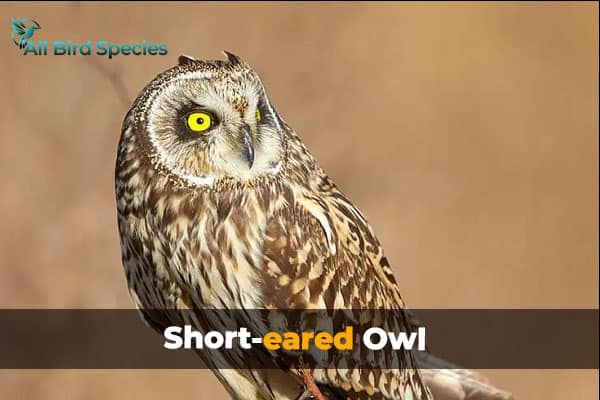
Across North America, Short-eared Owls are declining by 2.5% each year. Christmas Bird Counts from 1959 to 1988 showed a big drop in numbers. From 1966 to 1999, their populations kept falling, prompting the raptor trust to take action.
In the Northeast, they are seen as important birds to protect. This highlights the need to save their habitats.
In states like Massachusetts and Pennsylvania, they are endangered. Connecticut sees them as threatened. New York and Maryland consider them special. New York’s owl numbers fell by 33% from 1980-1985 to 2000-2005.
But, their winter numbers seem more stable. In some places, dozens gather in communal roosts.
Long-term monitoring is key to saving them. In New York, researchers check 21 sites in winter. Saving their habitats is crucial for their survival.
Owl Spotting: Best Locations in New Jersey
Knowing the best places to see owls may enhance your experience if you love birdwatching in New Jersey. The state has eight owl species. Many places are great for seeing these birds because of their rich wildlife and easy access.
Liberty State Park is a great start for birdwatchers. Here, you might see Great Horned and Screech owls. Great Swamp National Wildlife Refuge is perfect for spotting Barred owls. It’s also a great place to see wood ducks and wild turkeys.
Island Beach State Park covers over 3,000 acres, making it a great habitat for various species of owls. It has different habitats that attract many birds, including owls. The mix of beach and marsh is unique for spotting owls and other birds. The Pinelands National Reserve is another place to see different owl species in its varied habitats.
Let’s visit some key owl spotting locations in a detailed overview:
| Location | Notable Owl Species | Best Time to Visit |
|---|---|---|
| Liberty State Park | Screech Owl, Great Horned Owl | Dusk and Dawn |
| Great Swamp National Wildlife Refuge | Barred Owl | March (mating season) |
| Island Beach State Park | Various Owls | Year-round |
| Pinelands National Reserve | Diverse Species | Early Morning |
| Sandy Hook Peninsula | Various Raptors, including Owls | Migration Season |
Bring binoculars or a camera for a good view. Keeping a safe distance is important. It makes the experience better for both you and the birds. Enjoy the magic of birdwatching in New Jersey’s amazing wildlife spots. Every visit might bring a special moment with our feathered friends.
Why Owls Are Important for Ecosystems
Owls play a key role in keeping New Jersey’s nature in balance. They help control the numbers of small animals and birds. This is crucial for the health of our natural spaces.
In Northern New Jersey, five owl species live in different places. Each one helps the ecosystem in its own way. For example, Barred owls like forests, while Great Horned owls prefer forests and fields.
Studying owls shows us how they nest and live, providing insights into the raptor trust in Millington. Barred owls need big forests to nest, but human actions like cutting down trees harm their homes.
Being outside helps us feel better. It connects us to nature and boosts our health. Apps like Merlin Bird help us learn about birds, including owls, making our time outside more fun.
Owls are a sign of a healthy environment, indicating the presence of diverse species of owls. They show that all species are working together. Protecting their homes helps keep New Jersey’s nature in balance.
| Owl Species | Habitat Preference | Impact on Ecosystem |
|---|---|---|
| Great Horned Owl | Fragmented forests and fields | Regulates rodent populations |
| Barred Owl | Mature hardwood swamps are critical habitats for eight species of owls. | Controls bird and small mammal numbers |
| Northern Saw-whet Owl | Dense forests | Helps maintain species diversity |
| Barn Owl | Agricultural areas | Pest control for farmers |
| Eastern Screech Owl | Urban parks and woodlands | Supports urban biodiversity |
Conclusion
New Jersey is lucky to have many owl species. They improve our landscapes and keep nature in balance. Owls like the Barred Owl and Snowy Owl showcase our state’s wildlife beauty.
Each owl is special and makes us wonder. They remind us why we must protect their homes and numbers. This is why saving owls is so important.
Knowing and loving owls helps us understand their struggles. For example, Barn Owls were once common here but now face threats. Their numbers are dropping in places like Salem and Cumberland counties.
Learning about owls and their habitats can help. We can ensure that future generations see these amazing birds, and this is how we show our appreciation for owls.
Protecting owls is more than just saving birds. It’s about keeping nature’s beauty alive. When we support conservation, we help all kinds of life thrive, making our world a richer place.
Read More🐦Related Articles:
| Woodpeckers in Arizona |
| Crocodile Skink Facts, Size, Lifespan, Habitat, Diet, Pictures |
| What Do Hawks Eat |
| Yellow Birds in Colorado |
| White Birds in Hawaii |
Frequently Asked Questions
Q1. What are the most common owls in New Jersey?
The most common owl in New Jersey is the Eastern Screech Owl.
Q2. Do owls live in New Jersey?
Yes, various species of owls inhabit New Jersey.
Q3. Do snowy owls live in New Jersey?
Snowy owls occasionally visit New Jersey, particularly during winter months, but they are not resident species.
Q4. Are barred owls in New Jersey?
Yes, barred owls are commonly found in New Jersey.

